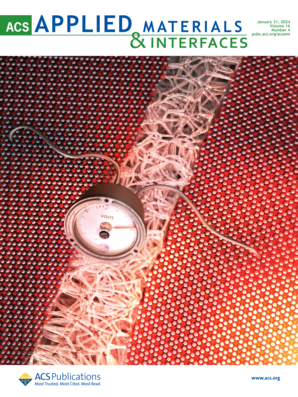Nanoscale Investigation of Elasticity Changes and Augmented Rigidity of Block Copolymer Micelles Induced by Reversible Core-Cross-Linking
IF 8.2
2区 材料科学
Q1 MATERIALS SCIENCE, MULTIDISCIPLINARY
引用次数: 0
Abstract
Drug-delivery systems have attracted considerable attention due to their potential to increase the bioavailability of certain drugs and mitigate side effects by enabling targeted drug release. Reversibly core-cross-linked block copolymer micelles providing a hydrophilic and potentially nonimmunogenic shell and a hydrophobic core suitable for the uptake of hydrophobic drugs are frequently considered because of their high stability against environmental changes and dilution. Ultimately, triggering core-de-cross-linking enables the implementation of strategies for targeted drug release, which requests insights into the impact of varying nanomechanical properties on the stability of individual micelles. Here, atomic force microscopy nanoindentation in aqueous media is applied to intact α-allyl-PEG80-b-P(tBGE52-co-FGE12) micelles to quantify changes in their nanomechanical properties induced by dithiobismaleimidoethane (DTME)-mediated Diels–Alder cross-linking of furfuryl moieties and sequential de-cross-linking by reduction of its disulfide bond by tris(2-carboxyethyl)phosphine. As a result of crosslinking by DTME, the apparent Young’s modulus of the micelles roughly doubles to 1.18 GPa. Changes to the Young’s modulus can be largely reversed by de-cross-linking. Cross-linked and de-cross-linked micelles maintain their structural integrity even in diluted aqueous media below the critical micelle concentration, in contrast to the micelles prior to crosslinking. Understanding the structure–property relationships associated with the observed augmented mechanical stability in native environments is crucial for improving the efficiency of drug encapsulation and introducing refined temporal and spatially controlled drug-release mechanisms.

可逆核交联诱导嵌段共聚物胶束弹性变化和增强刚性的纳米尺度研究
给药系统具有提高某些药物的生物利用度和通过靶向药物释放减轻副作用的潜力,因此备受关注。可逆去核交联嵌段共聚物胶束具有亲水性和潜在的非免疫原性外壳和疏水性内核,适合吸收疏水性药物,由于其对环境变化和稀释具有很高的稳定性,因此经常被考虑使用。最终,引发内核脱交联可以实施靶向药物释放策略,这就要求深入了解不同的纳米机械特性对单个胶束稳定性的影响。本文对完整的 α-allyl-PEG80-b-P(tBGE52-co-FGE12) 胶束在水介质中进行了原子力显微镜纳米压痕测试,以量化二硫代马来酰亚胺基乙烷 (DTME) 介导的糠基 Diels-Alder 交联和三(2-羧乙基)膦还原其二硫键所引起的纳米力学性能变化。通过 DTME 交联,胶束的表观杨氏模量增加了一倍,达到 1.18 GPa。杨氏模量的变化在很大程度上可以通过去交联而逆转。即使在低于临界胶束浓度的稀释水介质中,交联和脱交联胶束也能保持其结构完整性,这与交联前的胶束截然不同。了解与观察到的原生环境中增强的机械稳定性相关的结构-性质关系,对于提高药物封装效率和引入精细的时间和空间控制药物释放机制至关重要。
本文章由计算机程序翻译,如有差异,请以英文原文为准。
求助全文
约1分钟内获得全文
求助全文
来源期刊

ACS Applied Materials & Interfaces
工程技术-材料科学:综合
CiteScore
16.00
自引率
6.30%
发文量
4978
审稿时长
1.8 months
期刊介绍:
ACS Applied Materials & Interfaces is a leading interdisciplinary journal that brings together chemists, engineers, physicists, and biologists to explore the development and utilization of newly-discovered materials and interfacial processes for specific applications. Our journal has experienced remarkable growth since its establishment in 2009, both in terms of the number of articles published and the impact of the research showcased. We are proud to foster a truly global community, with the majority of published articles originating from outside the United States, reflecting the rapid growth of applied research worldwide.
 求助内容:
求助内容: 应助结果提醒方式:
应助结果提醒方式:


